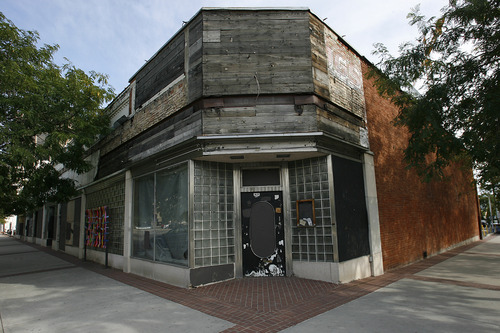This is an archived article that was published on sltrib.com in 2012, and information in the article may be outdated. It is provided only for personal research purposes and may not be reprinted.
Salt Lake City may be in the midst of a renaissance, but its long, drawn-out crusade against urban blight is anything but over.
Buildings boarded up and rotting on one hand; structures torn down for projects that didn't materialize on the other. That has left city officials with a dilemma: Is demolition the solution or the problem?
After three years of formulating a so-called demolition ordinance that seeks to save valuable commercial and residential structures from the wrecking ball, the City Council appears close to imposing new regulations that would require property owners to keep vacant buildings and houses "habitable" — fit to live or work in.
The proposed ordinance would allow for demolition only after a property owner submits plans for a replacement structure and obtains a building permit.
It also would allow demolition in rare cases where buildings or houses are deemed too rundown to repair. In such instances, the property owner would have to provide a bond for post-demolition landscaping and maintenance.
"We're going to make it a lot harder for people to demolish buildings. That's for sure," said City Councilman Kyle LaMalfa, who also is chairman of the Redevelopment Agency (RDA).
But the council cannot make the new regulations retroactive. Under Utah law, the city is prohibited from requiring owners of structures now boarded up to fix them or take them down as long as they don't pose a public safety risk.
Council members pointed to dilapidated buildings that have been empty for years that can legally remain in their present state, such as the structure that once housed the Zephyr Club on the corner of 300 South and West Temple, the old Yardstick shop on 300 South near State Street, and Eat-A-Burger on 200 South across from the Gallivan Plaza.
Council Chairman Soren Simonsen said the ordinance would prevent such blight in the future.
"Buildings vacated and intentionally left without maintenance become eyesores that drag down every property around them," he said.
Structures are abandoned for a variety of reasons, LaMalfa said, including "land banking" — where owners make no improvements on rundown properties while waiting, in some cases for years, for the value of their land to increase before selling it.
"Part of our debate is that we don't want to help these speculators who are waiting for someone else to raise their [property's] economic value while they do nothing," he said.
By contrast, LaMalfa said, the city doesn't want to "pinch" legitimate developers who are attempting to assemble properties in an effort to build new projects.
"There are some good developers out there," LaMalfa said. "We're not requiring them to rent [vacant properties], but they must keep them habitable."
But in tough economic times, the proposed ordinance could punish otherwise good landlords who are not able to immediately lease or rent their buildings, said Councilwoman Jill Remington Love.
"It's really complicated," she said. "Most of the time, landlords are not sitting on [their properties] to make a fortune. Hopefully, we're not making it worse for them."
Several council members, including Love, lamented that Salt Lake City's RDA is among the deadbeat landlords. The agency acquires properties in areas that the city determines are "blighted." Those buildings often become further dilapidated before the agency can forge development plans, usually in partnership with a private-sector entity.
For example, city-owned buildings, like those west of the Rio Grande Depot on 300 South between 500 West and 600 West, sit boarded up, attracting vagrants and the homeless and the crimes that often accompany them.
"We're going to have to maintain those structures. And that's a good thing," Love said. "But we haven't in the past because of the cost."
In addition, the proposed regulations demand landscaping from the RDA and private-sector developers when projects fail to materialize after demolition.
That section of the ordinance seeks to avoid outcomes such as the now-vacant lot on the east side of 300 West between 500 North and 600 North, where an RDA partnership with a private developer collapsed.
"If we're removing blight and have weed pastures for 10 to 20 years, we aren't removing blight," Simonsen said. Unkempt lots have a negative impact on commercial and residential values, he said. "Just talk to people who live or work near properties like this."
The council is tentatively scheduled to fine-tune the proposed ordinance at its Sept. 18 work session.
What's next
The Salt Lake City Council will continue its discussion of a proposed demolition ordinance Sept. 18, 451 S. State, room 321. To read the proposed ordinance, go to http://bit.ly/Txhctw.



